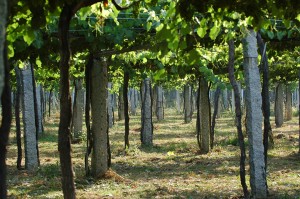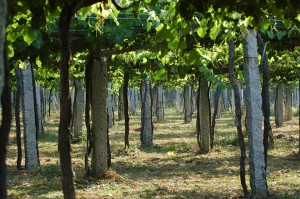2012 – a difficult year all around
October 19th, 2012 | Post Harvest
 With nearly 42 million kilos picked in 2011 (for the whole of our denomination), the latest vintage has seen a dramatic fall in overall volume. We do not have the official figure for 2012 yet, but we do know that in the case of our own bodega, the total kilos picked was roughly half that of last year. So what actually caused such a dramatic difference? My own opinion is that it was possibly a combination of factors.
With nearly 42 million kilos picked in 2011 (for the whole of our denomination), the latest vintage has seen a dramatic fall in overall volume. We do not have the official figure for 2012 yet, but we do know that in the case of our own bodega, the total kilos picked was roughly half that of last year. So what actually caused such a dramatic difference? My own opinion is that it was possibly a combination of factors.
For example, it is possible that after such a huge vintage in 2011 the vines themselves were simply exhausted, and would have produced much less no matter what the weather. The quantity that we produce varies from vintage to vintage, and even if our weather was stable and predictable, we would almost certainly end up with a different volume every year. I am not a biologist, merely an interested observer, and perhaps Angela would be able to explain this particular phenomena much better than me, but plants simply do not yield the same amount of fruit year-in year-out.
It is still obvious that by far the biggest single factor in this dramatic reduction was the weather. I had mentioned before that the flowering period in Galicia this year was unsettled, and this is where the problems started. Uneven pollination or perhaps none at all during this cool, damp period led to either smaller bunches, bunches suffering from ‘millerandage’ (where some berries in an individual bunch develop and other don’t), or no bunches at all.
However, the fruit that survived this poor flowering period was still under threat. Again the cooler temperatures and frequent rain of early summer provided perfect conditions for oidium (powdery mildew) and downy mildew. Unfortunately the only effective prevention for these diseases is to spray the crop with different treatments. Of course, we cannot spray when it’s raining, or when the vines are wet, and so it then becomes a question of finding the right moment to intervene. If you miss this window of opportunity you can potentially lose everything.
Indeed, we did have one or two of our smaller grape suppliers who did not bring us any fruit in 2012 – their crop was so small that it was actually not viable. (Please remember that in our area of tiny vineyards the amount sold to us by some producers is measured in 100’s of kilos rather than 1,000’s).
The fact that we were only 50% down on last year is therefore something of an achievement, as in other parts of Europe their losses have been even greater. Some parts of Burgundy for example, have lost nearly all their crop to hail, and England’s largest wine producer Nyetimber (430 acres/174 hectares), has scrapped their 2012 vintage altogether!
 With nearly 42 million kilos picked in 2011 (for the whole of our denomination), the latest vintage has seen a dramatic fall in overall volume. We do not have the official figure for 2012 yet, but we do know that in the case of our own bodega, the total kilos picked was roughly half that of last year. So what actually caused such a dramatic difference? My own opinion is that it was possibly a combination of factors.
With nearly 42 million kilos picked in 2011 (for the whole of our denomination), the latest vintage has seen a dramatic fall in overall volume. We do not have the official figure for 2012 yet, but we do know that in the case of our own bodega, the total kilos picked was roughly half that of last year. So what actually caused such a dramatic difference? My own opinion is that it was possibly a combination of factors.
For example, it is possible that after such a huge vintage in 2011 the vines themselves were simply exhausted, and would have produced much less no matter what the weather. The quantity that we produce varies from vintage to vintage, and even if our weather was stable and predictable, we would almost certainly end up with a different volume every year. I am not a biologist, merely an interested observer, and perhaps Angela would be able to explain this particular phenomena much better than me, but plants simply do not yield the same amount of fruit year-in year-out.
It is still obvious that by far the biggest single factor in this dramatic reduction was the weather. I had mentioned before that the flowering period in Galicia this year was unsettled, and this is where the problems started. Uneven pollination or perhaps none at all during this cool, damp period led to either smaller bunches, bunches suffering from ‘millerandage’ (where some berries in an individual bunch develop and other don’t), or no bunches at all.
However, the fruit that survived this poor flowering period was still under threat. Again the cooler temperatures and frequent rain of early summer provided perfect conditions for oidium (powdery mildew) and downy mildew. Unfortunately the only effective prevention for these diseases is to spray the crop with different treatments. Of course, we cannot spray when it’s raining, or when the vines are wet, and so it then becomes a question of finding the right moment to intervene. If you miss this window of opportunity you can potentially lose everything.
Indeed, we did have one or two of our smaller grape suppliers who did not bring us any fruit in 2012 – their crop was so small that it was actually not viable. (Please remember that in our area of tiny vineyards the amount sold to us by some producers is measured in 100’s of kilos rather than 1,000’s).
The fact that we were only 50% down on last year is therefore something of an achievement, as in other parts of Europe their losses have been even greater. Some parts of Burgundy for example, have lost nearly all their crop to hail, and England’s largest wine producer Nyetimber (430 acres/174 hectares), has scrapped their 2012 vintage altogether!


